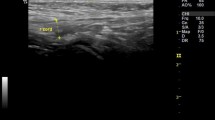Abstract
Purpose
The current study aimed to verify the usefulness of preoperative ultrasonographic evaluation of contralateral patent processus vaginalis (PPV) at the level of the internal inguinal ring.
Methods
This was a prospective study of patients undergoing unilateral inguinal hernia repair at two institutions during 2010–2011. The sex, age at initial operation, birth weight, initial operation side, and the preoperative diameter of the contralateral PPV as determined using ultrasonography (US) were recorded. We analyzed the incidence of contralateral inguinal hernia, risk factors, and the usefulness of the preoperative major diameter of the contralateral PPV. The follow-up period was 36 months.
Results
All 105 patients who underwent unilateral hernia repair completed 36 months of follow-up, during which 11 patients (10.5 %) developed a contralateral hernia. The following covariates were not associated with contralateral hernia development: sex (p = 0.350), age (p = 0.185), birth weight (p = 0.939), and initial operation side (p = 0.350). The preoperative major diameter of the contralateral PPV determined using US was significantly wider among patients with a contralateral hernia than those without a contralateral hernia (p = 0.001). When the 105 patients were divided into two groups according to cut-off values of the preoperative major diameter of the contralateral PPV (wide group, >2.0 mm; narrow group, ≤2.0 mm), a significant association was observed between the preoperative major diameter of the contralateral PPV and patient outcomes (p = 0.001).
Conclusions
We used US and confirmed the usefulness of a preoperative evaluation of the major diameter of the contralateral PPV at the level of the internal inguinal ring in pediatric patients with unilateral inguinal hernias.
Similar content being viewed by others
References
Ikeda H, Suzuki N, Takahashi A, Kuroiwa M, Sakai M, Tsuchida Y (2000) Risk of contralateral manifestation in children with unilateral inguinal hernia: should hernia in children be treated contralaterally? J Pediatr Surg 35:1746–1748
Tackett LD, Breuer CK, Luks FI, Caldamone AA, Breuer JG, DeLuca FG (1999) Incidence of contralateral inguinal hernia: a prospective analysis. J Pediatr Surg 34:684–688
Stanley TL, Yi-Horng L, Michael GC (2007) Current management of hernias and hydroceles. Semin Pediatr Surg 16:50–57
Sutcliffe JR, Taylor OM, Ambrose NS, Chapman AH (1999) The use, value and safety of herniography. Clin Radiol 54:468–472
Powell RW (1985) Intraoperative diagnostic pneumoperitoneum in pediatric patients with unilateral inguinal hernias: the Goldstein test. J Pediatr Surg 20:418–421
Downey EC, Maher DP, Thompson WR (1995) Diagnostic pneumoperitoneum accurately predicts the patent prosessus vaginalis. J Pediatr Surg 30:1271–1272
Sparkman RS (1962) Bilateral exploration in inguinal hernia in juvenile patients. Surgery 51:393–406
Juda ZJ (1996) The incidence of positive contralateral inguinal exploration among preschool children—a retrospective and prospective study. J Pediatr Surg 31:656–660
Wulkan ML, Wiener ES, VanBalen N, Vescio P (1996) Laparoscopy through the open ipsilateral sac to evaluate presence of contralateral hernia. J Pediatr Surg 31:1174–1177
Miltenburg DM, Nuchtern JG, Jaksic T, Kozinetiz C, Brandt ML (1998) Laparoscopic evaluation of the pediatric inguinal hernia—a meta-analysis. J Pediatr Surg 33:874–879
Van Glabeke E, Khairouni A, Gall O, Le Pointe HD, Jaby O, Larroquet M, Kotobi H, Chevet JB, Andry G, Gruner M (1999) Laparoscopic diagnosis of contralateral patent processus vaginalis in children under 1 year of age with unilateral inguinal hernia: comparison with herniography. J Pediatr Surg 34:1213–1215
Watanabe T, Nakano M, Endo M (2008) An investigation on the mechanism of contralateral manifestations after unilateral herniorrhaphy in children based on laparoscopic evaluation. J Pediatr Surg 43:1543–11547
Hata S, Takahashi Y, Nakamura T, Suzuki R, Kitada M, Shimano T (2004) Preoperative sonographic evaluation is a useful method of detection contralateral patent processus vaginalis in pediatric patients with unilateral inguinal hernia. J Pediatr Surg 39:1396–1399
Kervancioglu R, Bayram MM, Ertaskin I, Ozkur A (2000) Ultrasonographic evaluation of bilateral groins in children with unilateral inguinal hernia. Acta Radiol 41:653–657
Chou TY, Chu CC, Diau GY, Wu CJ, Gueng MK (1996) Inguinal hernia in children: US versus exploratory surgery and intraoperative contralateral laparoscopy. Radiology 201:385–388
Chen KC, Chu CC, Chou TY, Wu CJ (1998) Ultrasonography for inguinal hernias in boys. J Pediatr Surg 33:1784–1787
Lawrenz K, Hollman AS, Carachi R, Cacciaguerra S (1994) Ultrasound assessment of the contralateral groin in infants with unilateral inguinal hernia. Clin Radiol 49:546–548
Toki A, Watanabe Y, Sasaki K, Tani M, Ogura K, Wang ZQ, Wei S (2003) Ultrasonographic diagnosis for potential contralateral inguinal hernia in children. J Pediatr Surg 38:224–226
Erez I, Rathause V, Vacian I, Zohar E, Hoppenstein D, Werner M, Lazar L, Freud E (2002) Preoperative ultrasound and intraoperative findings of inguinal hernias in children: a prospective study of 642 children. J Pediatr Surg 37:865–868
Hoshino M, Sugito K, Kawashima H, Goto S, Kaneda H, Furuya T, Hosoda T, Masuko T, Ohashi K, Inoue M, Ikeda T, Tomita R, Koshinaga T (2014) Prediction of contralateral inguinal hernias in children: a prospective study of 357 unilateral inguinal hernias. Hernia 18:333–337
Kokorowski PJ, Wang HH, Routh JC, Hubert KC, Nelson CP (2014) Evaluation of the contralateral inguinal ring in clinically unilateral inguinal hernia: a systematic review and meta-analysis. Hernia 18:311–324
Conflict of interest
The authors (H.K., T.F., K.S., S.G., H.K., M.I., T.H., T.M., K.O., T.I., T.K., M.H., and H.G.) have no conflicts to disclose.
Author information
Authors and Affiliations
Corresponding authors
Additional information
H. Kaneda and T. Furuya have contributed equally.
Rights and permissions
About this article
Cite this article
Kaneda, H., Furuya, T., Sugito, K. et al. Preoperative ultrasonographic evaluation of the contralateral patent processus vaginalis at the level of the internal inguinal ring is useful for predicting contralateral inguinal hernias in children: a prospective analysis. Hernia 19, 595–598 (2015). https://doi.org/10.1007/s10029-014-1317-6
Received:
Accepted:
Published:
Issue Date:
DOI: https://doi.org/10.1007/s10029-014-1317-6




